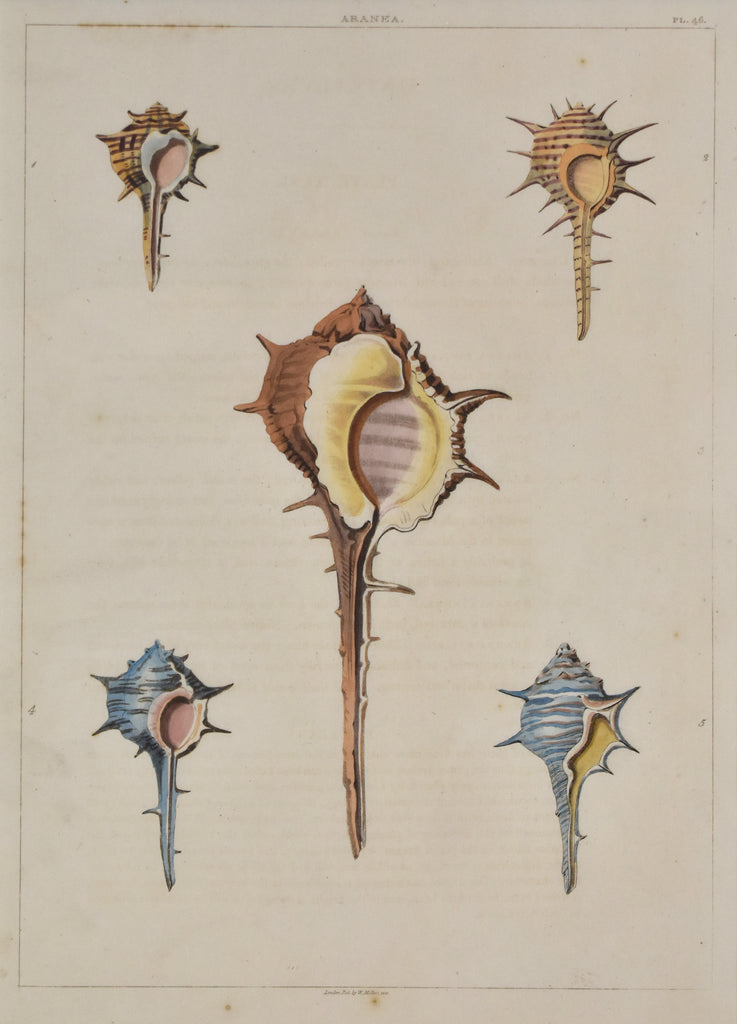-
Title: Aranea, PL. 46
-
Author: George Perry
-
Date: 1811
-
Medium: Hand-colored aquatint
-
Condition: Very Good +
-
Inches: 9 3/4 x 13 1/2 [Image]
-
Centimeters: 24.77 x 34.29 [Image]
-
Product ID: 3010031
George Perry, British naturalist and expert in malacology (the study of mollusks), published two major natural history works during his lifetime. One of them Arcana; or the museum of natural history, a richly-illustrated natural history magazine, was released in monthly installments from January 1810 to September 1811. He published his other major work, Conchology, or the natural history of shells, in 1811. The majority of Perry’s contemporaries ascribed to Linnaean taxonomy, the system of natural classification devised by Swedish botanist Carl Linnaeus in the eighteenth century. However, Perry adhered to the taxonomic system and theories of evolution popularized by French naturalist Jean-Baptiste Lamarck. As a result of these dissenting views, Perry’s work was deliberately ignored at the time by many of his fellow British naturalists.
Includes the following page of corresponding descriptive text:
UNIVALVES. PLATE XLVI.
Genus. ARANEA.
Character. Shell spiral; the mouth rounded; the spire short; the beak very long; the whole shell covered with irregular pointed spines; no calcar or spur upon the rostrum; number of the membranaceous divisions uncertain and irregular.
Species.
No. 1. Aranea Fasciata. Shell of a lively brown colour, striped crosswise with bands of rich brown; the mouth of a bright red colour; the spines variegated with brown. From a shell in the British Museum.
No. 2. Aranea Aculeata. Shell pale brown, striped with bands of an ochreous brown; spines very sharp, and acutely prominent; the mouth striped on the inside. A native of the African Seas.
No. 3. Aranea Conspicua. Shell of a pale red; the mouth yellow, and richly foliated by a broad spreading margin; the spines few, and strongly marked; mouth of a pale red colour. This striking shell was delineated from a specimen in the Museum of Mr. Bullock, and is supposed to be vary rare; it is probably a native of the Eastern Ocean, and is altogether of a very remarkable form and character.
No. 4. Aranea Cinerea. Shell grey; the beak invested with three spines; the mouth of a dark red, inclining to brown. Native place unknown.
No. 5. Aranea Pallida. Shell of a pale blue; the mouth very much narrowed and contorted and differing materially from most of its congeners in its general shape and contour. This shell is said to be found upon the African Coast.
REMARKS
No genus of shells has been more confused in the arrangement of the early Writers upon Conchology than the genus Aranea, and yet none can have a character more distinctly marked. It has been erroneously placed by Lister, Dargenville, and even Linnaeus, with the genus Murex, to which it has not the smallest analogy, its spinous or thorny character being quite sufficient to distinguish it from that and all others. In the preceding Plate we endeavoured to demonstrate the necessity of placing the two shells called the Tribulus major and the Tribulus minor, in the genus Aranea, by which means, and by the present Plate, we trust, all the difficulties of arrangement will be avoided, and the whole class brought to a determinate character. The Aranea has a distant resemblance to the Triplex, from which, however, it differs in the form of the beak, and in the height of its spire, as will be seen by a reference to each description.


